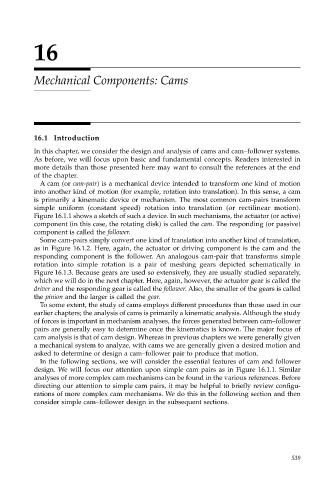Page 558 - Dynamics of Mechanical Systems
P. 558
0593_C16_fm Page 539 Tuesday, May 7, 2002 7:06 AM
16
Mechanical Components: Cams
16.1 Introduction
In this chapter, we consider the design and analysis of cams and cam–follower systems.
As before, we will focus upon basic and fundamental concepts. Readers interested in
more details than those presented here may want to consult the references at the end
of the chapter.
A cam (or cam-pair) is a mechanical device intended to transform one kind of motion
into another kind of motion (for example, rotation into translation). In this sense, a cam
is primarily a kinematic device or mechanism. The most common cam-pairs transform
simple uniform (constant speed) rotation into translation (or rectilinear motion).
Figure 16.1.1 shows a sketch of such a device. In such mechanisms, the actuator (or active)
component (in this case, the rotating disk) is called the cam. The responding (or passive)
component is called the follower.
Some cam-pairs simply convert one kind of translation into another kind of translation,
as in Figure 16.1.2. Here, again, the actuator or driving component is the cam and the
responding component is the follower. An analogous cam-pair that transforms simple
rotation into simple rotation is a pair of meshing gears depicted schematically in
Figure 16.1.3. Because gears are used so extensively, they are usually studied separately,
which we will do in the next chapter. Here, again, however, the actuator gear is called the
driver and the responding gear is called the follower. Also, the smaller of the gears is called
the pinion and the larger is called the gear.
To some extent, the study of cams employs different procedures than those used in our
earlier chapters; the analysis of cams is primarily a kinematic analysis. Although the study
of forces is important in mechanism analyses, the forces generated between cam–follower
pairs are generally easy to determine once the kinematics is known. The major focus of
cam analysis is that of cam design. Whereas in previous chapters we were generally given
a mechanical system to analyze, with cams we are generally given a desired motion and
asked to determine or design a cam–follower pair to produce that motion.
In the following sections, we will consider the essential features of cam and follower
design. We will focus our attention upon simple cam pairs as in Figure 16.1.1. Similar
analyses of more complex cam mechanisms can be found in the various references. Before
directing our attention to simple cam pairs, it may be helpful to briefly review configu-
rations of more complex cam mechanisms. We do this in the following section and then
consider simple cam–follower design in the subsequent sections.
539

